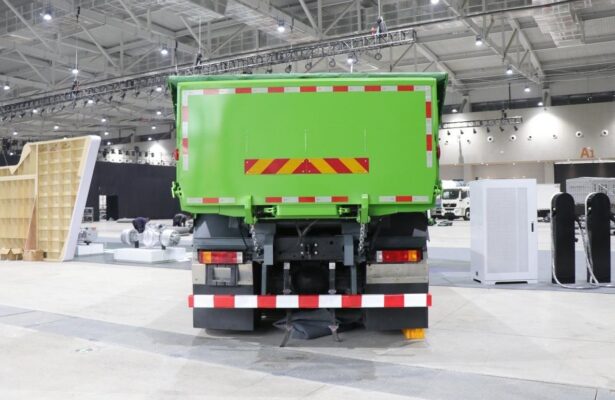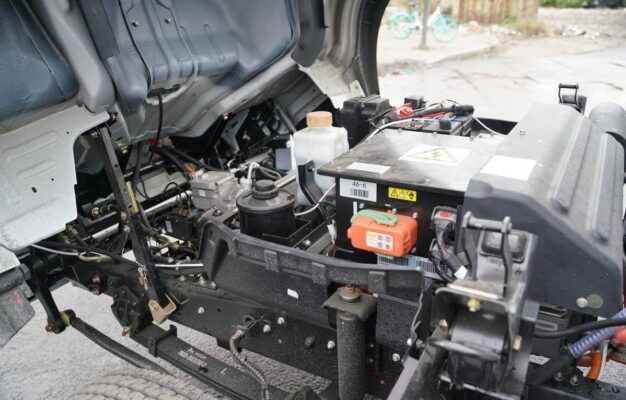Νέα για ηλεκτρικά φορτηγά
Precautions for using new energy electric vehicles in rainy season
Posted on by Electric Trucks
As the south is about to usher in the annual rainy season, the prospect of those days when quilts can’t be dried in Jiangsu, Zhejiang and Shanghai looms once again. The arrival of the rainy season is undoubtedly a challenging time for all, and new energy vehicles are no exception. For traditional cars, when water wading is too deep, it can easily lead to issues such as the exhaust pipe being flooded and the engine taking in water, potentially resulting in a cylinder top. New energy vehicles also require special attention and care during this time. Let’s delve into the detailed precautions for using electric vehicles in the rainy season.

- When the depth of road ponding is less than 10cm:
At such times, the vehicle must be driven slowly. The speed should be strictly controlled within 10 kilometers per hour. This cautious approach is essential to ensure the safety of both the vehicle and its occupants. Driving at a slow speed allows for better control and reduces the risk of water splashing into critical components. The driving wading distance is preferably not more than 500 μέτρα. Avoiding excessive wading distance minimizes the potential for water to seep into various parts of the vehicle.

Under no circumstances should one speed through by stepping on the accelerator. Hasty actions can lead to water being splashed forcefully into the high-voltage line interface or control system. These components are crucial for the proper functioning of the electric vehicle and are highly sensitive to water intrusion.
Για παράδειγμα, imagine a driver rushing through a puddle with a depth of less than 10cm at a high speed. The force of the water splashing can potentially damage the high-voltage line interface, leading to electrical malfunctions. This could result in a sudden loss of power or even pose a safety hazard. By adhering to the recommended speed limit and driving carefully, the risk of such incidents can be significantly reduced.

- When the road ponding is greater than 10cm:
In this situation, the vehicle must not attempt to pass forcibly. Changing routes is the wisest choice. Safety should always be the top priority. Water entering the high-voltage line can easily lead to a short circuit, which in turn can cause an electric fire. This is a serious risk that cannot be ignored.
When wading too deep or when the vehicle is soaked by ponding, it is essential to contact the insurance company and service station immediately. This prompt action can help mitigate potential damage and ensure that appropriate steps are taken to address the situation. It’s important to note that if the failure is caused by flooding due to human negligence or improper actions, it may not be covered by the warranty.

Για παράδειγμα, if a driver mistakenly attempts to drive through a deep puddle that exceeds 10cm in depth and the vehicle becomes submerged or experiences significant water intrusion, the consequences can be severe. Without immediate contact with the insurance company and service station, the damage may worsen over time, leading to costly repairs and potential safety hazards.
- Avoid dangerous driving actions in rainy days:
During rainy days, it is crucial to avoid sudden acceleration, sudden deceleration, sudden braking, and sharp turns. These actions can be extremely dangerous, especially when the roads are wet and slippery. Sudden acceleration can cause the wheels to spin and lose traction, while sudden deceleration or braking can lead to skidding. Sharp turns can also result in the vehicle losing control.

Για παράδειγμα, imagine a driver making a sharp turn on a wet road. The combination of the slippery surface and the sudden change in direction can cause the vehicle to skid and potentially collide with other objects or veer off the road. By maintaining a smooth and steady driving style, the risk of accidents can be greatly reduced.
- Outdoor charging and indoor power connections:
When charging vehicles outdoors, it is essential to ensure that there are safe protection facilities in place. This includes proper waterproofing and shielding to protect the charging equipment from rain and moisture. Indoor power connections must have leakage protection to prevent electrical hazards.

Για παράδειγμα, if outdoor charging is done without proper protection, rainwater can seep into the charging port or electrical connections, leading to short circuits or damage to the vehicle’s battery and charging system. On the other hand, indoor power connections without leakage protection can pose a risk of electric shock if there is any water leakage or electrical fault.
- Increased self-inspection in the rainy season:
In the rainy season, the humidity is relatively high. Vehicles should increase the frequency of self-inspection. If the vehicle reports faults such as static electricity, contact the service station in time. High humidity can affect the electrical components of the vehicle and potentially lead to various malfunctions.

Για παράδειγμα, static electricity buildup can occur due to the humid environment, which may interfere with the vehicle’s electronics. Regular self-inspection can help detect such issues early on and allow for timely corrective action. This can prevent more serious problems from developing and ensure the safe operation of the vehicle.
- Keeping the charging port clean and protected:
The dustproof and waterproof cover of the charging port must be kept closed at all times. This prevents debris or liquid from entering the charging port, which can cause damage to the charging system. If any debris or liquid does enter, it should be cleaned up immediately.

Για παράδειγμα, if the charging port is left open or if water and debris enter, it can lead to corrosion or short circuits. This can affect the charging efficiency and potentially damage the battery. By keeping the charging port clean and protected, the longevity and performance of the vehicle’s charging system can be maintained.
- Driving without an ABS system:
If your car does not have an ABS (Anti-lock Braking System), special care must be taken on slippery roads in rainy days. Controlling the speed well is crucial to prevent the vehicle from skidding. Generally, most electric logistics vehicles now are not equipped with driving stability systems. If you are used to driving passenger cars with advanced safety features, extra caution is needed when driving logistics vehicles.

Για παράδειγμα, without an ABS system, sudden braking on a slippery road can cause the wheels to lock up and lead to skidding. This can be extremely dangerous and may result in a loss of control of the vehicle. By driving at a moderate speed and avoiding sudden maneuvers, the risk of skidding can be minimized.
- Brake system alarm:
If the brake system alarm appears, stop the vehicle and check it in time. The brake assist system of electric vehicles is controlled by circuits, and these circuits are all under the chassis. If it is soaked by rainwater or the humidity is too high, it is easy to cause a short circuit, which is still relatively dangerous.

Για παράδειγμα, a short circuit in the brake system can lead to a failure in the braking function, increasing the risk of accidents. Promptly addressing the alarm and checking the brake system can help detect and resolve any issues before they become serious safety hazards.
- After leaving the wading road surface:
After leaving the wading road surface, it is important to keep a certain distance from the vehicle in front. When the brake pads are soaked, the braking force will be insufficient and the braking distance will increase. Maintaining a safe distance allows for enough time to react and stop the vehicle in case of an emergency.

Για παράδειγμα, if a driver fails to maintain a proper distance after leaving a wading area and needs to brake suddenly, the reduced braking force can lead to a collision with the vehicle in front. By being aware of this and keeping a safe distance, the risk of accidents can be reduced.
Εν κατακλείδι, using new energy electric vehicles in the rainy season requires careful attention and adherence to these precautions. While the above information is for reference only, it is essential to consult the manufacturer’s manual for specific guidelines and instructions. If you are interested in new energy electric logistics vehicles and want to know more information, communication and sharing of experiences can be valuable in ensuring safe and efficient operation. By taking these precautions seriously, we can minimize the risks associated with using electric vehicles in rainy weather and enjoy the benefits of sustainable transportation.